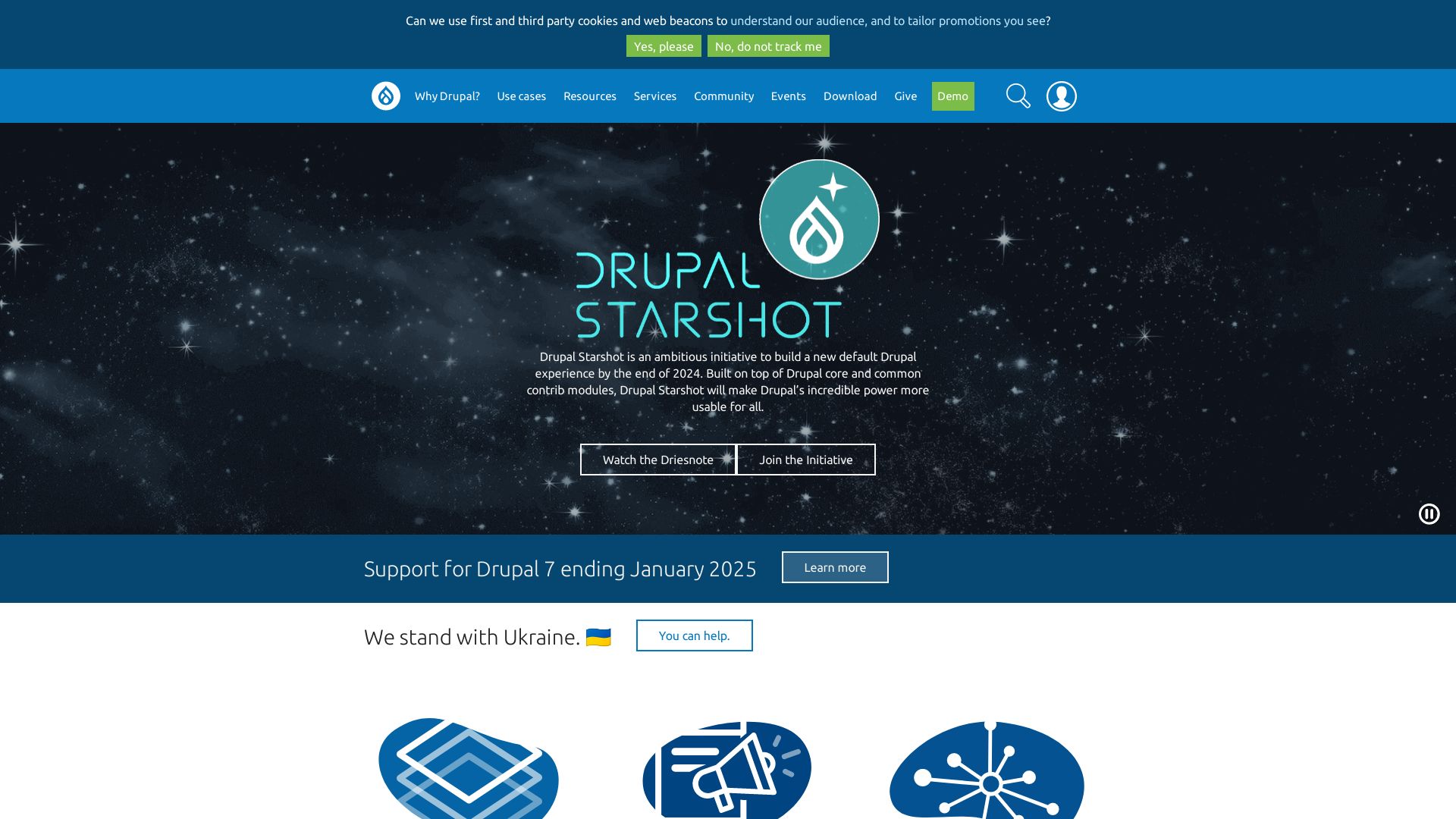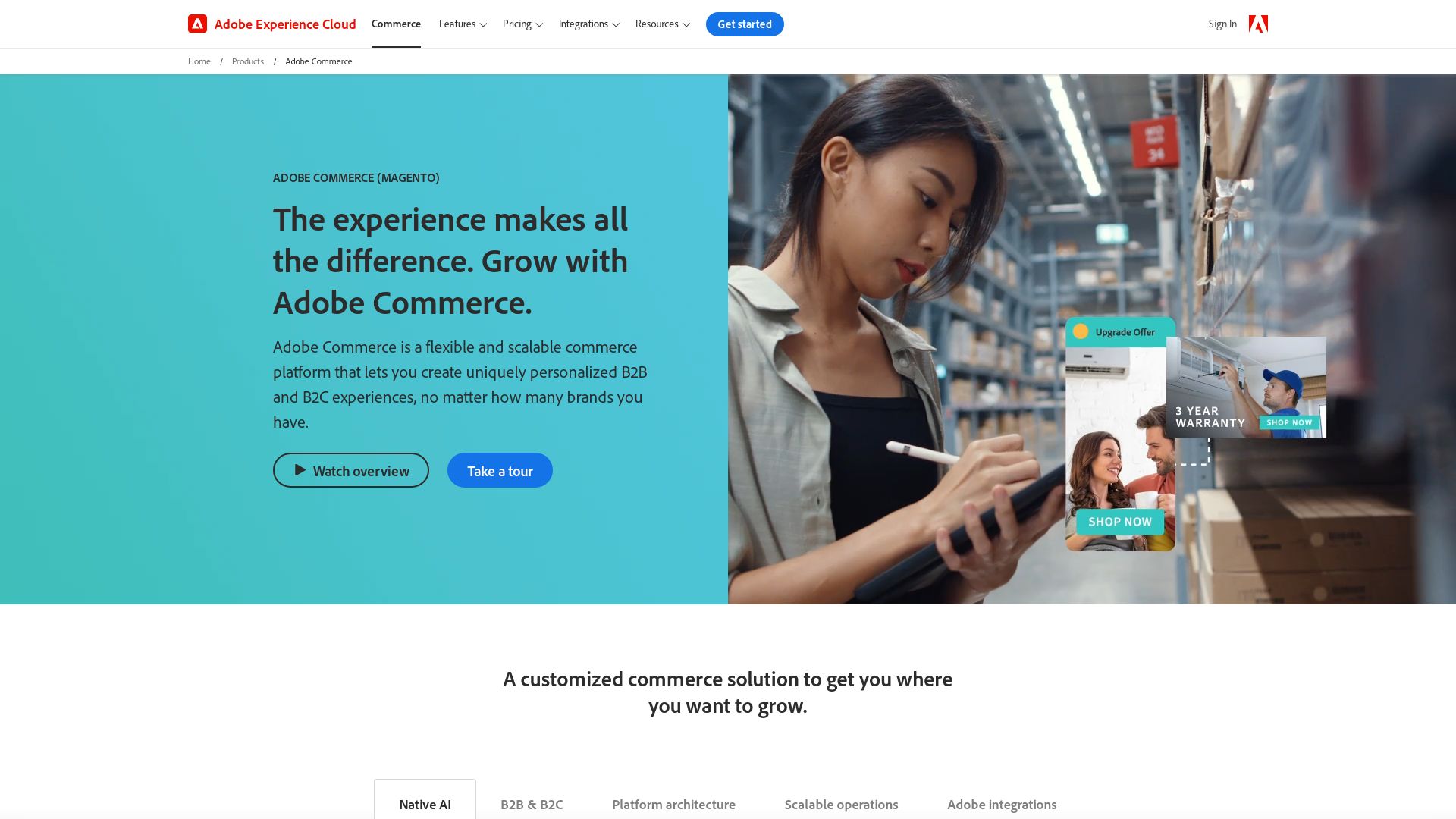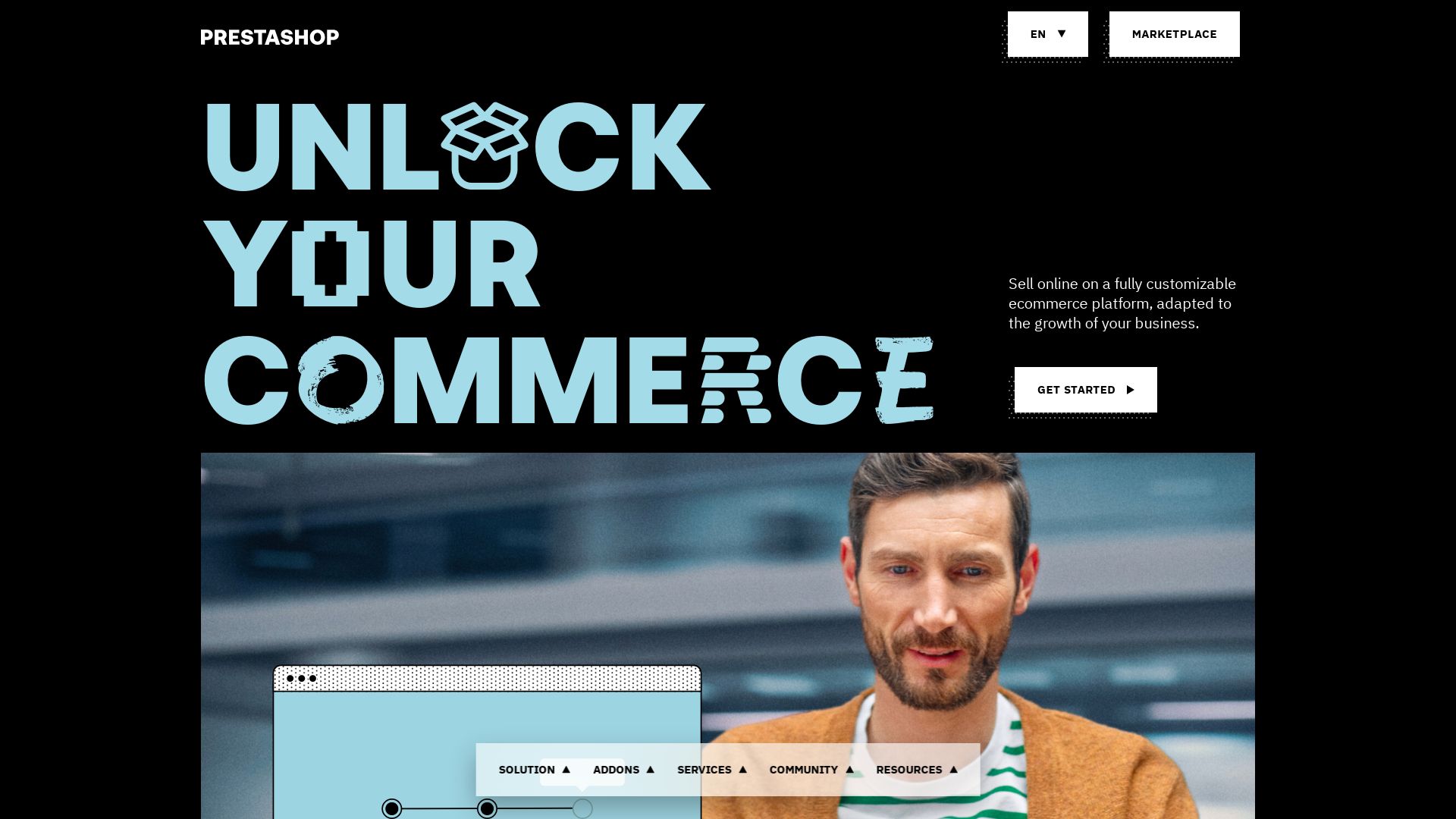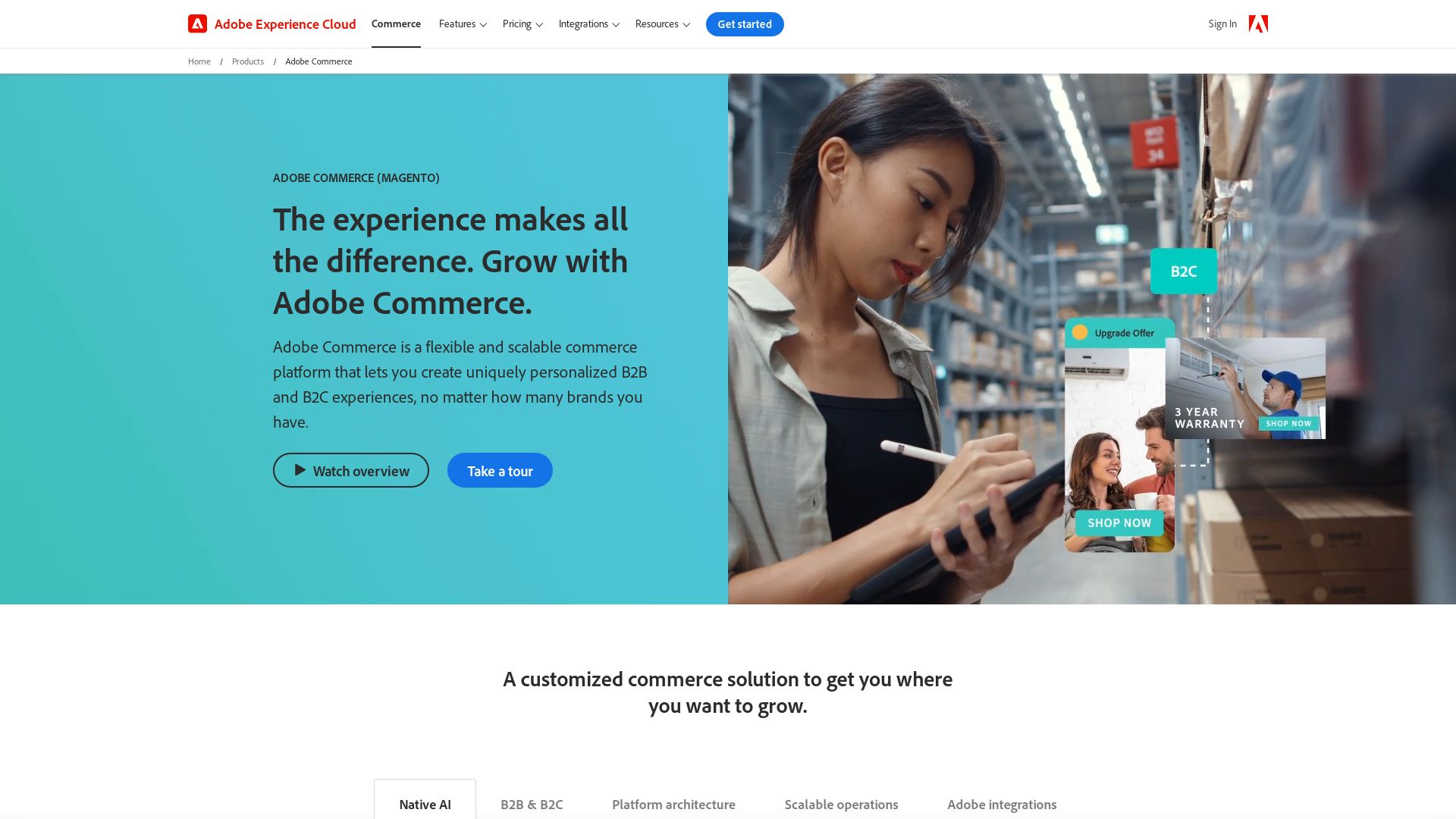Laravel is a renowned PHP framework, widely used in eCommerce development due to its scalability, security features, expressive syntax, and strong community support. With a market share of 35.87% among PHP frameworks, it empowers the creation of seamless online stores for businesses of all sizes. Laravel offers high-level security, extensive libraries, and support for complex web applications.

Considering alternatives to Laravel, one may explore Drupal, WordPress, Magento, PrestaShop, Adobe Commerce, WooCommerce, OpenCart, and Shopify within the eCommerce development realm.
Drupal

Founded by university students in 2000, Drupal has matured into a powerful, open-source eCommerce framework used globally to create business websites that cater to traditional eCommerce requirements. With strong community support and continuous innovation, Drupal enables complex eCommerce and community website creation tailored to user needs.
Top Features of Drupal
- Open-source eCommerce framework: In-built shopping cart, checkout form, and product catalog management.
- Customization freedom: Enables the creation of user-oriented and aesthetic designs.
- Compatible: Fit for different platforms due to responsive design.
- Modular: Allows developers to create custom module development, themed development, and enterprise web development.
- Headless commerce backend provider: Possible via JSON:API or custom REST resources.
| Features | Details |
|---|---|
| Global support | International currency, tax, language needs accommodation. |
| Community-driven | 45,000+ developers leading continuous improvement. |
| Integration | Ability to link with platforms like Amazon, eBay, and Etsy. |
Drupal Limitations
- Pricey: Compared to other regions, the cost visible in America is high.
- Complexity: Development and customisation costs can escalate based on project complexity.
- Growing needs: Despite maturity, needs ongoing modernization.
Drupal Pricing
While Drupal itself is open-source, the cost involved in Drupal website development varies depending on the customization, website size, and project complexity. Basic Drupal Commerce Websites can range between $20k-$40K, Custom Drupal Commerce Website- $50K-$100K. Services from DrupalPartners for migration to Drupal Commerce range from $500 to $10,000 based on project complexity.
Drupal Use Cases
Case 1: Large-scale business websites
Highly adaptable and designed for business growth, Drupal powers millions of websites globally. Its open-source nature allows complete control, best suited for creating large-scale business websites that require regular innovations.
Case 2: Multilingual eCommerce stores
With its inbuilt modules enabling multilingual site creation, Drupal accommodates international needs supporting different languages. This makes it ideal for developing multilingual eCommerce stores.
Case 3: Complex eCommerce structures
Drupal’s sophistication empowers you to link your eCommerce website with platforms like Amazon, eBay, and Etsy, making it a fitting tool for businesses with intricate eCommerce structures.
WordPress

WordPress, the leading CMS globally, powers up to 40% of websites and dominates the CMS market with a 64% share. It’s chiefly used for blog and website creation, although not primarily an eCommerce CMS, it can be equipped with WooCommerce for eCommerce purposes.
WordPress Top Features
- WooCommerce Plugin: Powers over 30% of online stores, providing capabilities like storefront creation, SEO, product page customization, multiple payment gateway integration, easy tax calculation, and more.
- Customization: With over 1,200 eCommerce-focused themes, and plugins for virtual product booking and upselling, personalizing WordPress sites is straightforward and limitless.
- Elastic search and SEO tools built-in, fostering enhanced site visibility.
- Automated Updates with a staging site for product testing, they offer smooth site maintenance.
| Features | Description |
|---|---|
| Marketing Automation | Automate your marketing campaigns for more efficient outreach. |
| Inventory Management | Keep track of your goods effortlessly. |
| Real-Time Shipping Prices | Provide real-time shipping costs to customers. |
WordPress Downsides
- Potential for plugin compatibility issues.
- Custom design and development can be expensive.
- Transaction fees from WooCommerce and PayPal.
WordPress Pricing
WordPress pricing can vary significantly depending on your needs. Domain registration, SSL, and other essentials can cost between $15-$50 monthly. Custom design ranges from $1,000-$10,000, and development services start at $25,000. Monthly marketing services generally run from $250-$5000, and hosting averages $20 monthly. Note that using WordPress itself is free, but additional plugins may incur extra costs.
WordPress Use Cases
Use Case 1 – Bloggers
WordPress, with its strong blogging roots, remains a favorite for bloggers due to its user-friendly interface, inbuilt SEO tools, and extensive customization possibilities.
Use Case 2 – Small eCommerce Businesses
Small businesses can utilize WordPress in combination with WooCommerce for their online storefronts without heavy investment, benefitting from its broad features, flexibility, and SEO capabilities.
Use Case 3 – Large Enterprises
Large corporations can harness WordPress’s robust and versatile framework to build complex websites and blogs, using premium support packages for optimal performance and security.
Magento

Delving deep into the realm of ecommerce solutions, let’s introduce Magento, a well-regarded open-source platform that has been boosting businesses since 2008. Used by over 250,000 merchants worldwide and holding 30% total market share, this comprehensive tool offers three distinct editions to meet the unique expectations of diverse clientele.
Magento Top Features
- Scalability: Catering to businesses of all sizes, from small-medium to multi-million dollar enterprises.
- Performance enhancements: Higher enterprise versions provide exceptional speed and stability, ensuring a fluid shopping experience.
- Advanced functions offered in the cloud edition are the choice of larger corporations craving for cutting edge technology.
| Magento Open Source | Magento Commerce | Magento Commerce Cloud |
|---|---|---|
| Known formerly as Magento Community, this edition is ideal for small to medium businesses. | An upgraded version of Community edition, this one is optimized for big product catalogs known previously as Magento Enterprise. | An edition equipped with advanced functions and preferred by large scale businesses. A blend of eCommerce strength and cloud technology. |
Magento Limitations
- While Magento offers scalability, its complexity may be a hurdle for smaller businesses new to ecommerce.
- The costs for extensions and SEO services, while optional, can significantly inflate the overall investment.
- Technical support services, while available, are circumscribed within Magento’s functionality.
Magento Pricing
In the discourse of cost, Magento Community incurs variable expenses such as domain name, SSL certificate, design, hosting, extensions, and development. These can range from $12,000 to $57,000+. Magento Commerce, contingent on annual sales, oscillates between $22,000 to $125,000. It’s worth highlighting that Magento’s licenses are essentially free, but built-in features and volume of sales can determine the final pricing.
Magento Use Cases
Use case 1: Small to Medium Businesses
With the Magento Open Source Edition, SMBs can leverage the power of Magento without significant expenditure. This edition is sturdy enough to sustain smaller operations while flexible for growth.
Use case 2: Large Scale Enterprises
The Magento Commerce and Cloud editions favor larger enterprises. Catering to a massive product catalog and offering enhanced performance for a seamless user experience, these editions bake in security features attuned to protect sensitive customer data.
Use case 3: Businesses transitioning from physical to digital
Coming from a brick-and-mortar background and making an online foray? Magento offers a comprehensive ecommerce solution for businesses in this critical transformation phase. Understanding the required investment in Magento development is crucial to gain ecommerce vigor.
PrestaShop

A free, open-source eCommerce solution, PrestaShop was founded in 2005 in Paris. The platform empowers merchants with complete ownership of their online store and its data, offering scalability from hundreds to millions in revenue. Known for its wide selection of features, it offers secure transactions, a friendly approach to SEO and mobile usage, and extensive customization options.
PrestaShop Top Features
- Customizable Themes: Choose from a wide array of themes to shape your online store.
- Add-on Modules: Extend the platform’s functionalities with various add-ons.
- Multiple Payment Options: Widely diverse payment selections cater to customers’ preferences.
- Secure Transactions: Safety is assured via SSL and HTTPS protocol.
- SEO-friendly: Improve your online ranking with SEO-centric features.
- Admin Capabilities: Perform inventory management, SEO optimizations, and custom promotions with advanced features.
| Attribute | Description |
|---|---|
| Translations | PrestaShop supports 75 languages, catering to a global audience. |
| Multi-store management | PrestaShop permits the operation of multiple online stores from one central hub. |
| Marketplace | Access to thousands of modules and themes for store customization through PrestaShop’s Marketplace. |
PrestaShop Limitations
- Additional costs linked to certain modules and advanced features.
- Despite being an open-source solution, certain advanced configurations may require developer skills.
- Some modules may be incompatible, leading to possible operational issues.
PrestaShop Pricing
PrestaShop is a free, open-source solution. However, users may encounter additional costs related to add-on modules and advanced features.
PrestaShop Use Cases
Use case 1
PrestaShop is ideal for those desiring full ownership and control over their online store. Its customization, flexibility, and robust features make it a suitable choice for entrepreneurs and businesses of all sizes.
Use case 2
For businesses targeting a global audience, PrestaShop provides translation support for 75 languages, making it an attractive solution for cross-border eCommerce.
Use case 3
Given PrestaShop’s multi-store management feature, the platform is beneficial for enterprises running multiple online stores, allowing seamless administration from a centralized hub.
Adobe Commerce

Adobe Commerce began its journey in 2018, when Adobe acquired Magento and integrated it into their cloud services. Evolved from Magento, it operates as a fully managed, cloud-based ecommerce platform that powers over 141,800 websites globally.
Adobe Commerce Top Features
- Integrates with Adobe Experience Cloud tools, such as Adobe Analytics Cloud and Adobe Marketing Cloud.
- Renders a seamless user experience across multiple devices due to its responsive web design.
- Supports customization of its source code courtesy of its open-source nature (built in PHP).
- Offers strong reporting functionality and a comprehensive set of analytical tools.
- Adopts a ‘Differentiate through Development’ approach, allowing it to handle unique selling scenarios or complex UX requirements.
| Additional Features | Details |
|---|---|
| SEO Alignment | Adobe Commerce aligns with SEO best practices, generating Google sitemaps, customized meta keyword descriptions, and keywords. |
| Marketplace Extensions | Enhances website functionality through purchasable marketplace extensions. |
| CMS Capabilities | Its content management system facilitates easy product uploads. |
Adobe Commerce Limitations
- Development cost can be steep due to extensive setup process; an enterprise-level store build can easily hit six figures and increase with build complexity and required integrations.
- Modifications to the source code for customization purposes can cause costs to rise.
- Additional costs may apply for advanced features, support system, and licensing fees for paid editions.
Adobe Commerce Pricing
Adobe Commerce operates on an opaque pricing model, and all infrastructure costs are included in the licensing fee. While Magento Open Source is free, it incurs additional costs for hosting, development, and extensions.
Adobe Commerce Use Cases
Use case 1: Large Enterprises
Adobe Commerce is an ideal platform for large businesses due to its comprehensive suite of features and robust infrastructure.
Use case 2: Small to Medium Businesses
Through Adobe Commerce Cloud, smaller businesses can leverage the extensive functionality of the Adobe platform on a smaller scale.
Use case 3: Companies Needing Customization
Companies that need to manage unique selling scenarios or deal with complex UX requirements will find Adobe Commerce’s ‘Differentiate through Development’ approach advantageous.
WooCommerce

An open-source ecommerce platform powering 3.9M online stores, WooCommerce, is the go-to solution when we discuss Laravel Alternatives. Tailored for WordPress websites, it takes pride in its flexibility and user-friendliness, equally beneficial to small-scale businesses and high-volume stores.
WooCommerce Top Features
- User-friendly and flexible, aiding a spectrum of businesses sizes.
- Works as an ecommerce extension for WordPress, compatible exclusively with Wordpress sites.
- Transforms an existing WordPress site into a full-fledged online store.
| Key Features | Benefits |
|---|---|
| Inventory & Order Management | Efficiently manage and track products and sales |
| Full Customization | Freedom to shape your web space |
| Secure Payment Portals | Deliver secure payment experience to customers |
| SEO Optimization | Improves store visibility in the online marketplace |
WooCommerce Disadvantages
- Limited to WordPress websites only.
- Some advanced features might require third-party extensions.
WooCommerce Pricing
As an open-source solution, WooCommerce is free to use. Additional costs may incur for premium plugins and themes.
WooCommerce Use Cases
Use Case 1
Small to mid-sized businesses: Offering website building, product additions, customization, WooCommerce can help such businesses set up their ecommerce store effortlessly.
Use Case 2
High-Volume Stores: Features like advanced inventory management, tax rates, and secure payment portals make it suitable for businesses with high-volume sales.
Use Case 3
Existing Wordpress Websites: WooCommerce allows an existing WordPress site to transform into a highly functional online store with ease.
OpenCart

As tech humorist, let me introduce you to the OpenCart, a delightful bundle of bytes that’s a free and open-source magic carpet ride into the world of eCommerce. Founded by Daniel Kerr, OpenCart is like a little e-commerce playground, hosting currently 292,051 gleefully twirling websites.
OpenCart Top Features
- Admin Dashboard for performance analysis that makes bookkeeping feel like a game of Tetris.
- Offers Discounts, Coupons, and Specials features; consider it your virtual Santa giving out gifts all year round.
- Works with numerous payment processing providers with no additional fees. Take payments like a street musician takes coin tosses.
- SEO optimized, and, like your favorite pair of pajamas, mobile-responsive by default.
| Unlimited Perks | Convenient Features |
|---|---|
| Unlimited Products | Digital Product Sales |
| Unlimited Categories | Multi-Currency Support |
| Unlimited Manufacturers | Printable Invoices |
OpenCart Downsides
- Like a superhero with a Kryptonite, functionality is limited without extensions.
- Some extensions may not always play nice, like siblings on a long car ride.
- Requires technical knowledge – You’re going to want your geek hat on for this one.
OpenCart Use Cases
Use case 1 – eCommerce businesses of any size
For eCommerce businesses of any size, Opencart is like the Goldilocks of platforms – it’s just right. Whether you’re a small start-up or a growing tycoon, it makes launching or switching to a new e-commerce platform a kin to leaping off a swing at the high arc.
Use case 2 – Single or multiple retail platforms
Managing single or multiple retail platforms? OpenCart is like your own personal octopus, deftly handling all your needs. Much like an efficient backstage crew at an award show, it ensures everything runs smoothly, even behind the scenes.
Use case 3 – Businesses with basic web development tasks
If your business is all about keeping it simple, OpenCart can be your new BFF. It may be basic, friends, but it’s never boring. And hey, if things get too comfy, there’s always a variety of extensions just waiting to jazz things up.
Shopify: The eCommerce Prodigy

Behold, Shopify – an eCommerce titan that offers affordable pre-made templates for designing your online store. But it doesn’t stop there. Let’s dive deep into what Shopify brings to the table.
Shopify: Features Worth Crowing About
- Template-rich: Offering a wide portfolio of ready-to-use designs.
- Freedom to Customize: Store owners can hire professional agencies for brand-specific aesthetics.
- SEO-centric: With nearly 43% of eCommerce sales coming from search, Shopify rightly focuses on SEO.
- Multiple page designs: Shopify stores can have separate designs for product pages, blogs, category pages, etc.
- User-retention tools: Features like search functionality, promotion tools, newsletter sign-ups, wishlist creation and product reviews.
| Building Type | Timeline |
|---|---|
| Native Builds | Depends on design and functionality requirements |
| Headless Builds (via Eastside Co’s Accelerator Programme) | Under four weeks |
The Downsides: Shopify’s Imperfections
- Branded aesthetics: You may need to shell out extra bucks for unique, brand-tailored aesthetics – Shopify’s templates may not suffice.
- Design cost bonanza: You could end up paying anywhere from $5,000 to $100,000+, depending on your design specifications.
- Custom functionality and integrations: While Shopify supports customizations, they add to your end expense.
- Page design limitations: Shopify’s inbuilt page templates may not extend to all your specific design requirements.
Show Me the Money: Shopify Pricing
Shopify includes a variety of costs – the monthly subscription rates vary from $29.99-$299.99, while costs for theme/template, custom website design and functionality development are add-ons.
Shopify Use Cases
Wooing the seasoned store owner
For established online merchants, Shopify offers a vast ecosystem of templates, custom functionality and integrations. Its SEO-centric approach aligns well with business imperatives.
Transitioning brick and mortar businesses
Traditional businesses trying to build an online presence can leverage Shopify’s quick-launch solution to go digital in under four weeks.
Wake up, web design agencies
Design agencies can tap into Shopify’s need for custom aesthetics and functionality, and ride the eCommerce wave.
Patrick Daugherty
Content writer @ Aircada. Merging AR expertise with a love for late-night gaming sessions.





